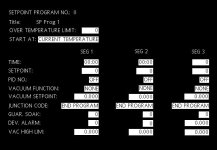TConnolly
Lifetime Supporting Member
I'm trying to set up a setpoint program in a G308 for a vacuum furnace. I want to allow the user to have up to 20 program profiles to select from, and each program profile has 25 segments (See graphic for example). Each segment contains 9 parameters.

I've attached a basic Crimson 3 DB (not a complete project DB) to give a general idea of what I'm after but I don't want to create folders for each segment and I'd rather not create folders for all 20 programs so I'm looking for suggestions from the Crimson Gurus on the best way to structure the tag DB. Obviously arrays are probably the best way to go but then how is the best way to handle multiple program profiles?
Also since not all segments will fit on one screen the operator is going to have to scroll through them - I'd rather use just one screen - I've worked out how to do this with an array on a dummy project but being able to do that will probably affect how to structure the database.
I'm entertaining the possibility of storing the program profiles on a CF card, in which case the 20 program capacity becomes moot.

I've attached a basic Crimson 3 DB (not a complete project DB) to give a general idea of what I'm after but I don't want to create folders for each segment and I'd rather not create folders for all 20 programs so I'm looking for suggestions from the Crimson Gurus on the best way to structure the tag DB. Obviously arrays are probably the best way to go but then how is the best way to handle multiple program profiles?
Also since not all segments will fit on one screen the operator is going to have to scroll through them - I'd rather use just one screen - I've worked out how to do this with an array on a dummy project but being able to do that will probably affect how to structure the database.
I'm entertaining the possibility of storing the program profiles on a CF card, in which case the 20 program capacity becomes moot.



